Australia to receive UK nuclear waste shipment amid bitter dispute over national storage facility

Two tonnes of nuclear waste will be shipped from the United Kingdom to Australia next year as debate continues over a national storage facility.
The shipment of four 500kg canisters inside a forged steel container called a TN-81 is part of a waste swap deal with the UK.
The intermediate-level waste is to be stored temporarily at Sydney’s Lucas Heights facility then sent to the national radioactive waste management facility the federal government plans to build near Kimba in South Australia.
However that project is the subject of a bitter dispute, and is years away. It will take several years for all the regulatory approvals to pass, and the government has declined to nominate when it will start construction.
In 1996 Australia sent spent fuel rods from its Hifar reactor – the predecessor to the existing Opal multi-purpose reactor – to the UK to be recycled into fuel for nuclear power plants. The “radiologically equivalent” waste will be sent to Australia under the 2022 waste repatriation project.
The Australian Radiation Protection and Nuclear Safety Agency (Arpansa) reported this week that it is working with the UK’s Office for Nuclear Regulation “for the inspection of radioactive waste containers, set to return to Australia from the Sellafield Reprocessing Plant”.
Related: Labor's position on nuclear waste bill means uncertainty remains over South Australian site
“The waste relates to the processing of spent fuel sent to the UK in earlier years from Australia’s former research reactor,” Arpansa said.
The Australian Nuclear Science and Technology Organisation (Ansto) says it successfully repatriated radioactive waste from France to Australia in 2015 and that the TN-81s had been used successfully in 180 nuclear shipments around the world.
The federal government says Lucas Heights does not have the room or the approvals to store the nation’s nuclear waste, which is spread across more than 100 sites, so it will commission a purpose-built dump. It settled on a site at Napandee, near Kimba in South Australia.
That plan has been deeply divisive.
A ballot run by the Australian Electoral Commission found more than 60% of people in the Kimba council area supported the facility, which would store mostly medical waste that is currently in separate sites all over the country.
But the traditional owners, the Barngarla people, say many were excluded from that ballot because they lived outside the council area. In a separate ballot, Barngarla voters unanimously rejected the proposal.
Chair of The Barngarla Determination Aboriginal Corporation, Jason Bilney, later welcomed amendments to the legislation that leave open the possibility of a judicial review.
Federal resources minister, Keith Pitt, has announced his intention to declare that Napandee will host the site. Before that declaration is made, however, there has been a consultation process for anyone who has a legal right or interest in the proposal.
Submissions to that consultation will close on Friday.
Pitt will consider any comments, and if he goes ahead and declares Napandee as the site, the federal government plans to acquire the land and begin preparations to build the facility – barring legal challenges.
Conservation Council of SA chief executive officer, Craig Wilkins, said the UK shipment highlighted the overall issues with creating a national facility. The facility will mostly store low-level waste but will temporarily store intermediate-level waste such as that coming from the UK.
Wilkins says Lucas Heights should store all waste until a permanent facility can be built.
“If this is genuinely our waste and we have a responsibility to look after it, then we need to do that properly,” he said.
Related: Should Australia build nuclear power plants to combat the climate crisis?
“We need a genuine, long-term national approach to dealing with our waste, rather than this ad hoc temporary fix of shifting some of the waste across to SA to temporarily park it in above-ground sheds while they work out what to do with the waste long term. It makes sense to get the long-term solution first.”
International best practice is to bury the waste in a deep disposal site in the safest place in the country, he said. “That work hasn’t been done yet, and until it’s done the waste should stay … at Lucas Heights.”
The government says waste from more than 100 sites needs to be consolidated in a purpose-built facility and that neither Lucas Heights nor the CSIRO storage site at Woomera were intended for permanent storage.
The industry department argues Lucas Heights “is not large enough” because any free space is needed for an expansion of research activities, and that it is only licensed for temporary storage.
Debate over nuclear storage continues, as does debate over Australia’s planned acquisition of nuclear-powered submarines, and debate over whether Australia needs nuclear power.

 Yahoo Finance
Yahoo Finance 